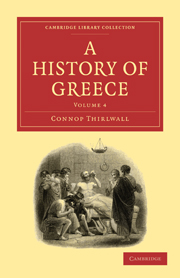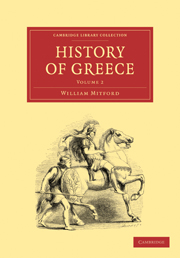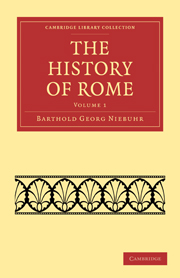Refine search
Actions for selected content:
23990 results in Ancient history

A History of Greece
-
- Published online:
- 05 July 2011
- Print publication:
- 27 May 2010
- First published in:
- 1837

A History of Greece
-
- Published online:
- 05 July 2011
- Print publication:
- 27 May 2010
- First published in:
- 1839
3 - Mother of the Messiah
-
- Book:
- Judaism and Imperial Ideology in Late Antiquity
- Published online:
- 01 June 2011
- Print publication:
- 20 June 2011, pp 87-124
-
- Chapter
- Export citation
Frontmatter
-
- Book:
- Judaism and Imperial Ideology in Late Antiquity
- Published online:
- 01 June 2011
- Print publication:
- 20 June 2011, pp i-iv
-
- Chapter
- Export citation
Introduction
-
- Book:
- Judaism and Imperial Ideology in Late Antiquity
- Published online:
- 01 June 2011
- Print publication:
- 20 June 2011, pp 1-8
-
- Chapter
- Export citation
Conclusion
-
- Book:
- Judaism and Imperial Ideology in Late Antiquity
- Published online:
- 01 June 2011
- Print publication:
- 20 June 2011, pp 213-218
-
- Chapter
- Export citation
Index
-
- Book:
- Judaism and Imperial Ideology in Late Antiquity
- Published online:
- 01 June 2011
- Print publication:
- 20 June 2011, pp 245-247
-
- Chapter
- Export citation
1 - Esau, Jacob's Brother
-
- Book:
- Judaism and Imperial Ideology in Late Antiquity
- Published online:
- 01 June 2011
- Print publication:
- 20 June 2011, pp 9-44
-
- Chapter
- Export citation
Preface
-
- Book:
- Judaism and Imperial Ideology in Late Antiquity
- Published online:
- 01 June 2011
- Print publication:
- 20 June 2011, pp vii-viii
-
- Chapter
- Export citation
Contents
-
- Book:
- Judaism and Imperial Ideology in Late Antiquity
- Published online:
- 01 June 2011
- Print publication:
- 20 June 2011, pp v-vi
-
- Chapter
- Export citation
2 - Coronation in the Temple
-
- Book:
- Judaism and Imperial Ideology in Late Antiquity
- Published online:
- 01 June 2011
- Print publication:
- 20 June 2011, pp 45-86
-
- Chapter
- Export citation
4 - Renovatio Imperii
-
- Book:
- Judaism and Imperial Ideology in Late Antiquity
- Published online:
- 01 June 2011
- Print publication:
- 20 June 2011, pp 125-171
-
- Chapter
- Export citation
Bibliography
-
- Book:
- Judaism and Imperial Ideology in Late Antiquity
- Published online:
- 01 June 2011
- Print publication:
- 20 June 2011, pp 223-244
-
- Chapter
- Export citation
5 - King Messiah
-
- Book:
- Judaism and Imperial Ideology in Late Antiquity
- Published online:
- 01 June 2011
- Print publication:
- 20 June 2011, pp 172-212
-
- Chapter
- Export citation
Abbreviations
-
- Book:
- Judaism and Imperial Ideology in Late Antiquity
- Published online:
- 01 June 2011
- Print publication:
- 20 June 2011, pp 219-222
-
- Chapter
- Export citation

The History of Greece
-
- Published online:
- 13 June 2011
- Print publication:
- 31 October 2010
- First published in:
- 1808

The History of Greece
-
- Published online:
- 13 June 2011
- Print publication:
- 31 October 2010
- First published in:
- 1808

The History of Rome
-
- Published online:
- 05 June 2011
- Print publication:
- 20 May 2010
- First published in:
- 1828

The History of Rome
-
- Published online:
- 01 June 2011
- Print publication:
- 20 May 2010
- First published in:
- 1842

Alien Wisdom
- The Limits of Hellenization
-
- Published online:
- 01 June 2011
- Print publication:
- 18 December 1975
